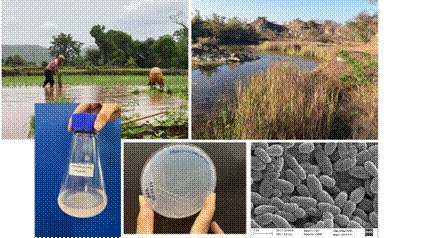Ministry of Science & Technology
India can bank on its own natural methane mitigator to tackle climate challenges
प्रविष्टि तिथि:
05 AUG 2024 6:04PM by PIB Delhi
India’s first cultures of indigenous natural methane mitigating agents reported from rice fields and wetlands, mainly from Western India can help tackle upcoming climate challenges. While the world is experiencing global warming and climate change, there are some diligent micro-organisms in this world, doing their job perfectly in mitigating the ill effects of global warming. Methane, the second most important greenhouse gas, has 26 times more global warming potential compared to carbon-di-oxide. Wetlands, ruminants, rice fields, landfills are sources of methane produced by the action of methanogens. In a counteractive way, methanotrophs or methane oxidizing bacteria oxidize this methane and build up their biomass, breathing oxygen and producing CO 2 and H 2 O as we do. Methanotrophs are natural methane mitigating agents and are present in all the environments where methane and oxygen both are available. Wetlands, rice fields, ponds and other water bodies are the habitats where these grow in abundance. It’s because of the activities of methanotrophs that atmospheric methane values have not skyrocketed over the years. Dr. Monali Rahalkar, a scientist from MACS Agharkar Research Institute, an autonomous institute of Department Science and Technology, with her team, have isolated and described India’s first cultures of indigenous methanotrophs from rice fields and wetlands, mainly from Western India. Isolating methanotrophs from India, they published the first novel methanotroph description from India, a novel genus and species -- Methylocucumis oryzae. The specialty of this methanotroph was that it had a characteristic oval and elongated shape, similar to that of a cucumber, and hence the name ‘methane eating cucumbers’ was given to this novel genus. Her team could culture another similar organism from a rice field again, in subsequent years though the isolation of this particular methanotroph. Recently Methylocucumis oryzae were found to be important methanotroph components of a stone quarry in Pune, situated amidst the popular hill, Vetal Tekdi or ARAI hill. This hill has its own unique flora and fauna including the stone quarry water having unique invertebrates and mollusks. Dr. Rahalkar’s team also recently documented the abundance of methanotrophs in the water filled quarry, which indicated that an active methane cycle operated in this unique habitat. After about 6 years of description and around 10 years of isolation of its first member, Methylocucumis oryzae remain phylogenetically unique. No strains have been reported or cultured from any other country or parts of the world. It has a remarkably large size compared to other bacteria and is equal to the size of a small yeast (3-6 µm). Another unique feature of this bacterium is that it has a strict mesophilic nature and cannot grow above 37ºC while most of the other methanotrophs can tolerate or grow at 37ºC or even at 40ºC.
The bacterium forms light pale pink colored colonies, and the genome is indicative of a carotenoid pathway. In recent years, this methanotroph was also found to promote the growth of rice plants by inducing early flowering and increased grain yield. Methanotroph was added in transplanted rice plants in pot experiments using the local popular high yielding rice variety Indrayani. The current constraints with Methylocucumis are slow growth which limits growing this culture on a larger scale, needed for mitigation and biotechnological applications. Nevertheless, there is evidence that this organism exists in nature in abundance in wetlands and rice fields and may be performing its function in a meticulous manner. These insights about the unique methanotroph Methylocucumis oryzae were published recently in Indian Journal of Microbiology. Earlier reports on the three strains of this methanotroph and its genome have been published in Microbial Ecology, Antonie van Leeuwenhoek, Frontiers in Microbiology and International Microbiology. The discovery of such a unique and probably endemic methanotroph is important for further studies of this important group with respect to the upcoming climate challenges. Further improvements in culture conditions and large-scale cultivation may help in more applications of this organism.
Link to the article: https://rdcu.be/dMUUw
Insights into Methylocucumis oryzae, a Large-sized, Phylogenetically Unique Type Ia Methanotroph with Biotechnological Potential | Indian Journal of Microbiology (springer.com)
Diverse type I and type II methanotrophs cultivated from an Indian freshwater wetland habitat | International Microbiology (springer.com)

***
KSY/PSM
(रिलीज़ आईडी: 2041799)
आगंतुक पटल : 3442